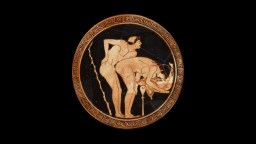Kama Sutra isn’t just about sex. It’s a guidebook for pleasure

- According to Hindu philosophy, Kama means "sensory pleasure" and is only one of the four great pursuits of human life. Sex is a part of this.
- The Kama Sutra is more than just a guidebook about sexual positions: It is an entire catalogue about courtship and relationships.
- The book is meant as advice, not a prescription for everyone to follow.
How often do you talk about sex? Not the bluff and boasting talk after a few drinks, but with honesty and sincerity? The kind of conversation that examines it with the seriousness that it deserves? We all know that sexual desire is as natural a part of life as is hunger or thirst. And yet, we hardly ever give it attention beyond euphemisms, jokes, or in talks with our intimate partner(s).
This is why the Kama Sutra is so important.
A guide to pleasure
In Indian philosophy, Kama relates to all sensory pleasure and is the first (and least) of the four goals of human life. The others are, in order of importance: Artha (material prosperity), Dharma (proper conduct), and Moksha (the extinguished self). Sex is only one kind of Kama, and things like chocolate, a glass of wine, listening to your favorite artist, or a long bath equally could be called Kama. While Kama is the least of the four goals of a human life (Purushartha) that should not be understood that sensory pleasure is bad or to be repressed. Those who grew up in a European-Christian tradition are familiar with more prudish takes on sex and pleasure, but this is certainly not the case in Hindu philosophy, and it is the very antithesis of the Kama Sutra.
A Sutra is simply a guide, and you can have one for anything. In fact, the author of the Kama Sutra, Vātsyāyana, is otherwise known for his commentaries on the “logic” sutras known as the Nyāya Sūtras. So, the Kama Sutra is a guidebook for pleasure. It’s about how to have a good time.
The Kama Sutra isn’t just about sex
When the Kama Sutra was translated in the 19th Century, Victorian prudes censored all reference to sex. Richard Burton’s 1883 version, the reason many in the West are familiar with the Kama Sutra at all, tried to include cleverly euphemized sexual sections. Yet, flowery metaphors and an overuse of ellipsis only make the imagination work harder. The Kama Sutra was nonetheless banned until 1962 in the UK and America.
Today, a lot of people in the West only know it for its eroticism. Yet the Kama Sutra is much broader than we might suppose. In fact, only the second chapter (of seven) concerns sex. The others include marriage advice, courtship tips, and even how to have an affair. The latter is likely ironic. It is not an encouragement for infidelity but rather a reminder for husbands to take care of their wives.
There is also a lot of advice on how to simply have a good time. For example, as after-dinner entertainment, the Kama Sutra recommends “well-known games peculiar to different regions, like plucking the mango, eating roasted grain, nibbling lotus stems, collecting new leaves, squirting water, pantomimes, the silk-cotton tree game, and mock-fights with wild jasmine flowers.”
Vātsyāyana lists 64 “arts” by which we can make ourselves more attractive to others. Some, we might agree with (and there is even evidence to support), like being good at a musical instrument, being able to dance well, and being hugely knowledgeable about a variety of subjects. Others, though, will perhaps only have a more niche appeal: the “art of teaching parrots and starlings to speak,” “playing on musical glasses filled with water,” and sorcery.
It’s not a guide to sexual gymnastics, either
But there is a lot about sex, as well. The Kama Sutra is meant to be a guide to aid the pleasure of both sexual partners in as natural a way as possible. It is not meant to be some erotic tick sheet of sexual positions. Sex is not supposed to be osteopathic torture, but it ought to take into account, for example, differences in body types, ages, and libido. The positions are offered as tips, not prescriptions. The aim is always pleasure — not training for months to do position #132 without pulling a muscle.
All of the erotic images we associate with the Kama Sutra were neither in the original version nor in Burton’s 1886 edition. We must appreciate Vātsyāyana all the more for doing his job with descriptions alone. There are, for instance, eight different types of biting: “When the skin is pressed down on both sides, it is called the ‘swollen bite’… when a small portion of the skin is bitten with two teeth only, it is called the ‘point’… When biting is done with all the teeth, it is called the ‘line of jewels.'”
Likewise, there are many different types of kisses. The standard vanilla kiss of two tilted heads is “the bent kiss.” The kiss of two people of different heights is the “turned kiss.” There are modest kisses, respectful kisses, and passionate kisses. There are ones that involve one lip or two, some on the mouth and some on the body, some with a tongue and some with the teeth. There is even one you might have tried but didn’t know it had a 2000-year old history: the “throbbing kiss,” in which you take the entirety of your partner’s lips in your mouth, as if you are sucking their face. Some might find this an exciting idea. Others, not so much.
There is some more curious advice scattered throughout the text. For instance, when it comes to your home-made dildos, Vātsyāyana recommends using wood over the more common tin/lead (for “realism”). For men worried about their penis size, he offers rubbing the offending organ with an ointment of crushed hairy caterpillars for guaranteed growth.
The modern importance of the Kama Sutra
The Kama Sutra is ostensibly intended for young, rich, educated men, but it is not utterly misogynistic. If a woman (such as a virginal bride) is shy or modest, the Kama Sutra recommends three days of handholding and bathing (no sex allowed). Sex is never obligatory, and even when slapping and biting are mentioned, it is noted that one can only go so far as their partner does to them too. Female pleasure is often central, and the notion that “sex is only for making babies” is dismissed as nonsense.
There is a lot going on in the Kama Sutra, but it is not intended to be a definitive guide that everyone must do. It is a resource to be mined for whatever help we need or want. Not everyone will be into orgies, homosexuality, sex toys, polyamory, or yogic sexual positions. And that’s okay. The Kama Sutra is a guide for people to maximize pleasure on their own terms. It’s whatever works for you.
The Kama Sutra is part of a tradition that recognizes sex as a natural part of life. A lot of research shows how sex is good for us — both for our body and our mind. The Kama Sutra knew that long before science figured it out.
Jonny Thomson runs a popular Instagram account called Mini Philosophy (@philosophyminis). His first book is Mini Philosophy: A Small Book of Big Ideas.





